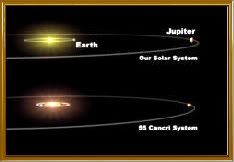 Planets Planets Everywhere - Are there some with water to drink?
Planets Planets Everywhere - Are there some with water to drink?
There has been a search going on for extra-solar planets for a long time. It has been going on seriously for a couple of decades and there has been some success in finding them. Perhaps most people are not as familiar as I am with the fact that there has been success in finding these planets.
The planets found so far tend to be very large ones, many would dwarf Jupiter and many orbit their sun much closer than the planets of our own solar system. As of July 16, 2008 there are 307 candidates detected according to "The Extrasolar Planets Encyclopaedia" on their Catalogue Page. Of course that is "candidates" rather than saying "planets" as it is rather hard to prove completely without any possible doubt. That site I found not really for the casual reader but has a ton of very current information on it.
 I find the Wikipedia Page on it -- "Extrasolar planet -- Wikipedia, the free encyclopedia" -- to be a much more interesting and digestible read. (image to right -- image from Wikipedia)
I find the Wikipedia Page on it -- "Extrasolar planet -- Wikipedia, the free encyclopedia" -- to be a much more interesting and digestible read. (image to right -- image from Wikipedia)
While most of the planets detected have been huge rating up to 13 times the mass of Jupiter which is the limiting mass beyond which a body is considered a Brown Dwarf Star rather than a planet in part this is because it is much easier to detect the much larger bodies using the only techniques we have. Also most of the planets we have detected are close to their suns and tend to be around smaller suns for similar reasons. A very large planet orbiting close to a small star is much easier to detect. The planet is larger in ratio to the sun and moves faster so the changes that are made are easier to observe.
We are detecting smaller bodies even so. From this we seem to be able to predict that the low mass planets may outnumber the Jupiter-like planets by a facter of 3 to 1.
Sometimes they seem to be a bit picky and arbitrary on things like definitions of what a planet is though... that is why Pluto is no longer considered a planet. According to the International Astronomical Union, the working definition for extrasolar planets established in 2001 and last modified in 2003 are:
1. Objects with true masses below the limiting mass for thermonuclear fusion of deuterium (currently calculated to be 13 Jupiter masses for objects of solar metallicity) that orbit stars or stellar remnants are "planets" (no matter how they formed). The minimum mass/size required for an extrasolar object to be considered a planet should be the same as that used in our Solar System.
2. Substellar objects with true masses above the limiting mass for thermonuclear fusion of deuterium are "brown dwarfs", no matter how they formed nor where they are located.
3. Free-floating objects in young star clusters with masses below the limiting mass for thermonuclear fusion of deuterium are not "planets", but are "sub-brown dwarfs" (or whatever name is most appropriate).
It seems that free-floating planetary-mass objects (planemo) or "rogue planets" or "interstellar planets" aren't included in the discussion on the Wikipedia page.
Personally I think it is very short sited to have a definition of "planet" that is dependant on orbital characteristics. I think that more important should be structure, size, and origin. In my definition, many of the larger moons would be included as planets. There would be ice planets and rock planets, There would also perhaps be a few varieties of gas planet and then there would be the "space junk" which in my definition would be masses which weren't large enough to form into a relative sphere. Thus a body like the earth which formed around another star, but which was thrown out of its orbit and captured by a gas giant or perhaps becomes free floating in interstellar space would still be a planet. But that is my personal view.
 It does seem to me that if we can ever figure out some exotic interstellar propulsion system or other method of interstellar transport, there just might be reason to go to other stars. There seem to be other planets to look at and some might be like ours. System of 55 Cancri compared with our Solar System. (image to left -- image from Wikipedia)
It does seem to me that if we can ever figure out some exotic interstellar propulsion system or other method of interstellar transport, there just might be reason to go to other stars. There seem to be other planets to look at and some might be like ours. System of 55 Cancri compared with our Solar System. (image to left -- image from Wikipedia)
Later!
~ Darrell
92.


 Stumble It!
Stumble It!

No comments:
Post a Comment